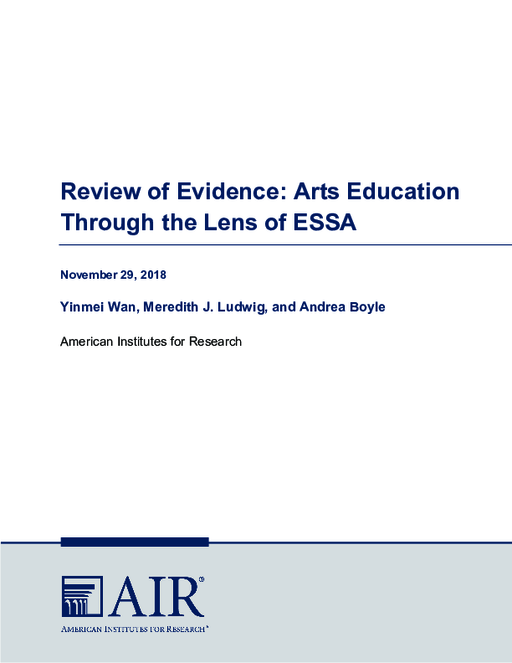Breadcrumb
- Wallace
- Reports
- Arts Education Research Through ...
Arts Education Research through the Lens of the Every Student Succeeds Act

- Author(s)
- Yinmei Wan, Meredith J. Ludwig, and Andrea Boyle
- Publisher(s)
- American Institutes for Research
Summary
How we did this
Researchers used targeted search criteria to identify and screen more than 7,400 relevant studies on arts education interventions in education research databases and clearinghouses. Of those 7,400, 286 reports were reviewed by What Works Clearinghouse-certified reviewers. Reports were classified according to definitions of ESSA tiers of evidence. To gain a fuller picture of findings across all well-designed studies, researchers then recorded the magnitude of effects from 20 studies of arts education interventions and meta-analyzed those effect sizes.
The Review of Evidence: Arts Education Through the Lens of the Every Student Succeeds Act (ESSA) explores research on approaches to arts education. It identifies 88 different evidence-based studies of “interventions”—which are loosely defined as teaching strategies or programs—that may qualify for federal education funding according to ESSA evidence standards.
The report also offers program implementation and research recommendations for policymakers, practitioners, and researchers.
ESSA is the federal law that governs United States K-12 education policy. It considers arts and music to be essential components of a well-rounded education. The law includes programs and funding to help states, local education agencies, and schools teach arts and music. Applicants must show evidence that proposed programs can affect student academic outcomes.
Researchers at the American Institutes for Research (AIR) reviewed hundreds of research reports to understand what kinds of arts programming meets ESSA evidence criteria. They also sought to understand the size of different program effects on student outcomes.
AIR’s evidence review explains how ESSA addresses the issue of arts education. It summarizes funding opportunities for implementing arts education interventions for PK-12 students. It also explains ESSA’s tiered evidence standards. Tiers I-III must “demonstrate a statistically significant effect on improving student outcomes or other relevant outcomes,” with varying levels of rigor. Tier IV evidence must “demonstrate a rationale” that an intervention is “likely to improve student outcomes or other relevant outcomes.”
AIR researchers cite and categorize the 88 different evidence-based studies according to these evidence standards. These studies make a range of arts education activities ESSA-eligible.
The two arts types with the largest number of evidence-based studies are music and visual arts. Most studies offer a theory or research-based rationale for why interventions should improve student outcomes. Of studies that do show statistically significant effects, the average effect is moderate.
The researchers conclude the evidence review with recommendations. For practitioners, chosen interventions should align with a program’s goals, intended outcomes, available evidence base, and appropriate funding stream. A conservative approach may be best. Going forward, more rigorous research can provide stronger evidence for arts education.

Critically assess the theoretical and empirical support behind a proposed arts education intervention.
Key Takeaways
- The federal 2015 Every Student Succeeds Act considers arts and music to be essential components of a well-rounded education.
- Under ESSA, arts education funding opportunities can be used to support activities like teacher professional development, school improvement efforts, supports for English learners, arts courses, instructional materials, and extended learning time programs. They can also be used to support arts-focused charter or magnet schools.
- To be eligible to receive funding for arts and music education, applicants must show evidence that proposed programs can affect student academic outcomes.
- Evidence must align with ESSA’s tiered evidence standards.
- Researchers identified 88 evidence-based studies that make a range of arts education interventions ESSA-eligible.
- The majority of evidence-based studies offer a theory or research-based rationale for why interventions should improve student outcomes. For those studies that offer statistically significant evidence, average effects are generally moderate.
Materials & Downloads
What We Don't Know
What are the effects of arts education on diverse student populations in a range of settings?


